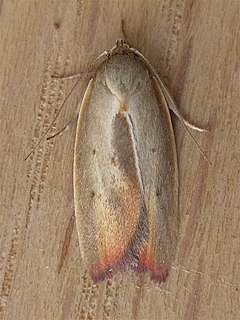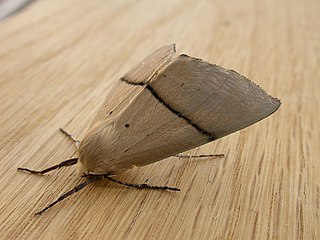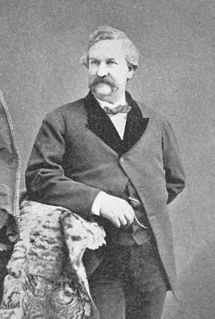
The geometer moths are moths belonging to the family Geometridae of the insect order Lepidoptera, the moths and butterflies. Their scientific name derives from the Ancient Greek geo γεω, and metron μέτρον "measure" in reference to the way their larvae, or inchworms, appear to measure the earth as they move along in a looping fashion. A very large family, it has around 23,000 species of moths described, and over 1400 species from six subfamilies indigenous to North America alone. A well-known member is the peppered moth, Biston betularia, which has been subject of numerous studies in population genetics. Several other geometer moths are notorious pests.

Notodontidae is a family of moths with approximately 3,800 known species. The family was described by James Francis Stephens in 1829. Moths of this family are found in all parts of the world, but they are most concentrated in tropical areas, especially in the New World.

Lophocoronoidea is a superfamily of insects in the order Lepidoptera. There is a single extant genus, Lophocorona, in the family Lophocoronidae. These are small, primitive nocturnal moths restricted to Australia whose biology is largely unknown.

Ptyoptila is a monotypic moth genus of the family Oecophoridae described by Alfred Jefferis Turner in 1946. Its only species, Ptyoptila matutinella, was described by Francis Walker in 1864. It is found in Australia, where it has been recorded from Queensland, New South Wales, the Australian Capital Territory and Victoria.

Ipanica is a genus of moths of the family Noctuidae erected by George Hampson in 1908. Its only species, Ipanica cornigera, the laced day-moth, was first described by Arthur Gardiner Butler in 1886. It is found along the Australian east coast from Queensland to Tasmania.

Eudesmeola is a monotypic moth genus of the family Erebidae erected by George Hampson in 1926. Its only species, Eudesmeola lawsoni, or Lawson's night moth, was first described by Felder and Rogenhofer in 1874. It is found in the dry inland areas of Australia.
Lophozancla is a monotypic moth genus of the family Erebidae. Its only species, Lophozancla prolixa, is found in Australia's Western Australia and the Northern Territory. Both the genus and the species were first described by Turner in 1932.

Iropoca is a monotypic moth genus in the subfamily Lymantriinae erected by Alfred Jefferis Turner in 1904. Its only species, Iropoca rotundata, the iropoca moth, was first described by Francis Walker in 1855. It is found in the Australian states of Victoria, New South Wales and Queensland.

Gastrophora is a monotypic moth genus in the family Geometridae. Its only species, Gastrophora henricaria, the fallen bark looper or beautiful leaf moth, is found in the south-east corner of Australia. Both the genus and species were first described by Achille Guenée in 1857.

Parepisparis is a genus of moths in the family Geometridae erected by George Thomas Bethune-Baker in 1906.

Henry Edwards, known as "Harry", was an English stage actor, writer and entomologist who gained fame in Australia, San Francisco and New York City for his theatre work.

Poecilasthena pulchraria is a moth of the family Geometridae. It is found in Australia and New Zealand. It was first described by Edward Doubleday in 1843 and named Acidalia pulchraria.

Lophocampa montana is a moth of the family Erebidae. It was described by William Schaus in 1911. It is known from Poás Volcano in Costa Rica.

Parepisparis lutosaria, the bright twisted moth, is a species of moth of the family Geometridae first described by Rudolf Felder and Alois Friedrich Rogenhofer in 1875. It is known from the Australian states of Queensland, New South Wales and Victoria.

Hyblaea constellata is a moth in the family Hyblaeidae first described by Achille Guenée in 1852. It is found in India, Sri Lanka, south-east Asia, including China, Japan, Taiwan, Myanmar and Thailand. It is also found in Queensland, Australia.

Pseudohemihyalea edwardsii, or Edwards' glassy-wing, is a moth in the family Erebidae. It was described by Alpheus Spring Packard in 1864. It is found in the United States from western Oregon and the Columbia Gorge in southern Washington south to California, in the south-west east to western New Mexico. The habitat consists of oak woodlands and mixed hardwood forests at low elevations.
Hypsidia grisea is a moth in the family Drepanidae. It was described by Malcolm J. Scoble and Edward David Edwards in 1988. It is found in Australia.

Siganus virgatus, the barhead spinefoot, doublebar rabbitfish or doublebar spinefoot is a species of marine ray-finned fish, a rabbitfish belonging to the family Siganidae. It is found in the Indo-Pacific region.

Homoranthus virgatus commonly known as twiggy homoranthus, is a species of flowering plant in the family Myrtaceae and is found growing in coastal areas of northern New South Wales and in Queensland. It is an upright shrub with wand-like branches, aromatic foliage and white to pink flowers in small clusters at the end of branches.
The Lepidopterists' Society is a non-profit organization dedicated to the study of butterflies and moths (Lepidoptera). Founded in 1947 and based in the United States, it has an international focus and membership.

















